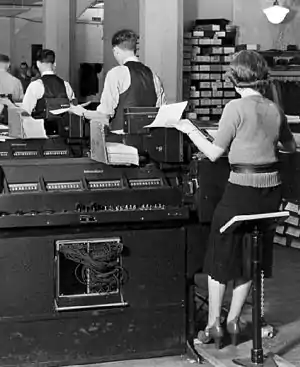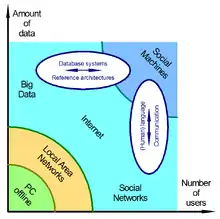Social machine
A social machine is an environment comprising humans and technology interacting and producing outputs or action which would not be possible without both parties present.


The growth of social machines has been greatly enabled by technologies such as the Internet, the smartphone, social media and the World Wide Web, by connecting people in new ways.[1]
Concept
The idea of social machines has been around for a long time, discussed as early as 1846 by Captain William Allen, and also by authors such as Norman Mailer, Gilles Deleuze and Félix Guattari.[1]
Social machines blur the lines between computational processes and input from humans.[2] They often take the form of collaborative online projects which produce web content, such as Wikipedia,[3] citizen science projects like Galaxy Zoo, and even social networking site such as Twitter have also been defined as social machines.[4] However, a social machine does not necessarily produce outcomes which directly affect the individuals or machines involved and an alternative viewpoint states that Social Machines are "rather than being an intentionally engineered piece of software - the substrate of accumulated human cross-system information sharing activities".[5][6]
Nigel Shadbolt et al. say that the telos of the social machine is specific to its participants, whereas the telos of a platform is independent of its participants’ purposes; the platform is there to facilitate communication. A social machine may also spread across more than one platform, depending on how its participants interact, while a platform like Twitter could host many thousands of social machines.[1]
An academic field investigating the idea has been active[7] since Tim Berners-Lee's book Weaving the web. Social machines are characterised as 'social systems on the Web ... computational entities governed by both computational and social processes'.[8] Tim Berners-Lee and James Hendler expressed some of the underlying scientific challenges with respect to AI research[9] using semantic web technology as a point of departure.
Nello Cristianini and Teresa Scantamburlo argued that the combination of a human society and an algorithmic regulation forms a social machine.[10]
See also
References
- Shadbolt, Nigel; O'Hara, Kieron; De Roure, David; Hall, Wendy (2019), The Theory and Practice of Social Machines, Springer, ISBN 978-3-030-10888-5
- Shadbolt, Nigel R.; Daniel A. Smith; Elena Simperl; Max Van Kleek; Yang Yang; Wendy Hall (2013). "Towards a Classification Framework for Social Machines" (PDF). WWW 2013 Companion. Retrieved 25 May 2014.
- Berners-Lee, Tim; J. Hendler (2009). "From the Semantic Web to social machines: A research challenge for AI on the World WideWeb" (PDF). Artificial Intelligence. 174 (2): 156–161. doi:10.1016/j.artint.2009.11.010. Retrieved 25 May 2014.
- Meira, Silvio R. L.; Buregio, Vanilson A. A.; Nascimento, Leandro M.; Figueiredo, Elaine; Neto, Misael; Encarnacao, Bruno; Garcia, Vinicius Cardoso (2011). "The Emerging Web of Social Machines". 2011 IEEE 35th Annual Computer Software and Applications Conference. pp. 26–27. arXiv:1010.3045. doi:10.1109/COMPSAC.2011.12. ISBN 978-1-4577-0544-1.
- Luczak-Roesch, M.; Tinati, R.; O'Hara, K.; Shadbolt, N. (2015). Socio-technical Computation (PDF). CSCW'15 Companion Proceedings of the 18th ACM Conference Companion on Computer Supported Cooperative Work & Social Computing. ACM. pp. 139–142. doi:10.1145/2685553.2698991. ISBN 9781450329460.
- Luczak-Roesch, M.; Tinati, R.; Shadbolt, N. (2015). When Resources Collide: Towards a Theory of Coincidence in Information Spaces (PDF). WWW 2015 Companion. ACM. pp. 1137–1142. doi:10.1145/2740908.2743973. ISBN 9781450334730.
- Shadbolt, N.; Kleek, M. Van; Binns, R. (2016-04-01). "The rise of social machines: The development of a human/digital ecosystem". IEEE Consumer Electronics Magazine. 5 (2): 106–111. doi:10.1109/MCE.2016.2516179. ISSN 2162-2248.
- "About". SOCIAM. Retrieved 25 May 2014.
- Hendler, J.; Berners-Lee, T. (2010-02-10). ""From the Semantic Web to Social Machines"". AI Journal. 2 (174). doi:10.1016/j.artint.2009.11.010.
Further reading
- Shadbolt, Nigel; O'Hara, Kieron; De Roure, David; Hall, Wendy (2019), The Theory and Practice of Social Machines, Springer, ISBN 978-3-030-10888-5
- Anatol W. Holt (1997), Organized Activity and its Support by Computer, Springer, ISBN 978-0792347088
- Wade Roush (1 Aug 2005), "Social Machines", MIT Technology Review
- Peter Semmelhack (2013), Social Machines: How to Develop Connected Products That Change Customers' Lives, John Wiley & Sons, ISBN 978-1118637296
- Ursula Martin, Alison Pease (2013), "Mathematical Practice, Crowdsourcing, and Social Machines", Intelligent Computer Mathematics, pp. 98–119, arXiv:1305.0900, Bibcode:2013arXiv1305.0900M, ISBN 978-3-642-39319-8
- Donath, Judith (2014), The Social Machine: Designs for Living Online, MIT Press, ISBN 9780262027014
- James Hendler and Alice Mulvehill (2016), Social Machines: The Coming Collision of Artificial Intelligence, Social Networking, and Humanity, Apress, ISBN 148421157X
External links
- SOCIAM: The Theory and Practice of Social Machines — slide show
- Observing Social Machines Part 1: What to Observe — pre-print